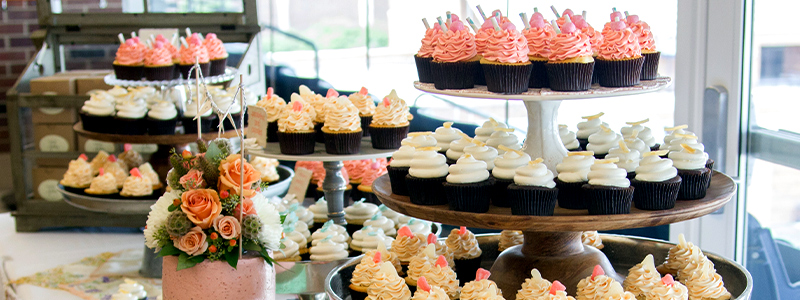Comprehending the Art of Pastry Shop Products: From Fresh Baked Breads to Irresistible Pastries and Finger Foods
From the scientific research behind the best loaf of bread, where fermentation and gluten advancement play critical roles, to the skill needed for producing layered pastries, each facet exposes a compelling story of workmanship. The versatility of finger foods highlights exactly how taste and appearance can be skillfully incorporated to engage diverse preference choices.
The Science of Bread Making
At the heart of every loaf of bread exists a fascinating interaction of chemistry and biology. The procedure of bread making begins with the combination of flour, water, yeast, and salt-- each component playing a crucial role in the final item.
Yeast, a living microorganism, ferments the sugars present in the flour, producing co2 and alcohol while doing so. The carbon dioxide gas develops bubbles in the dough, creating it to increase and create a light texture. The temperature and moisture throughout fermentation significantly influence yeast activity and, as a result, the bread's taste and appearance.

Mastering Pastry Techniques
Exactly how can one achieve the fragile balance of appearance and flavor that defines extraordinary bread? Grasping bread techniques needs a deep understanding of active ingredients, techniques, and the scientific research behind them. Fundamental to this craft is the choice of top quality components-- flour, butter, sugar, and eggs-- each playing an essential function in the last product's flavor and appearance.
The technique of lamination, which includes folding layers of dough and butter, develops the desired flakiness in pastries like croissants and smoke bread. Precision in temperature is essential, as butter should stay cool to guarantee optimal layers. Likewise, proper blending approaches, such as the creaming method for cakes, make sure even consolidation of air and fat, causing a light and ventilated crumb.
Moreover, maintaining the best moisture degrees throughout cooking can dramatically affect the outcome, guaranteeing that pastries increase properly and accomplish that golden-brown surface. The art of pastry also requires perseverance and technique; each effort boosts one's skill and understanding of the elaborate balance required to produce alluring pastries that delight the detects. Proficiency in these methods inevitably differentiates a knowledgeable bread cook from an amateur.
Kinds of Finger Foods
The globe of culinary delights extends beyond pastries to encompass a vast selection of finger foods, which are commemorated for their ease and adaptability. These bite-sized treats are ideal for social events, providing an array of flavors and appearances that satisfy diverse palates.

On the sweeter side, bite-sized cupcakes and mini tarts provide a fascinating finish to any type of meal, attracting those with a craving for sweets. In addition, cheese and charcuterie boards function as a sophisticated choice, like it allowing visitors to personalize their attacks with an array of meats, fruits, cheeses, and nuts.
Flavor Profiles in Baking
Baking is an elaborate dance of taste accounts that integrates wonderful, tasty, and umami notes to produce a harmonious experience for the taste. Recognizing these accounts is necessary for bakers seeking to elevate their creations.
Components such as chocolate and sugar introduce complicated sweet notes that can either control or complement various other tastes. Components like flavors, natural herbs, and cheeses can change an easy dough right into a multifaceted taste experience.
Umami, regularly ignored in cooking, plays a considerable duty in enriching flavors. Active ingredients such as aged cheeses, fermented products, or perhaps particular nuts add to a mouthwatering deepness that enhances general preference.
Additionally, the interplay of level of acidity from ingredients like buttermilk or citrus passion can lighten up tastes, providing a rejuvenating counterpoint to sweet taste. By thoughtfully integrating these taste accounts, look at this web-site bakers can craft items that resonate with diverse tastes, creating an extraordinary cooking experience. Ultimately, mastering taste accounts is key to advancement in the globe of cooking.
Necessary Cooking Devices and Ingredients
Understanding flavor profiles in cooking collections the phase for selecting the right tools and ingredients that help with the production of extraordinary baked items. A dependable collection of cooking frying pans-- such as sheet frying pans, loaf frying pans, and cake frying pans-- is essential for accomplishing desired structures and shapes.
Flour offers as the backbone of the majority of recipes; picking the right kind-- be it all-purpose, pastry, or bread flour-- can drastically influence the outcome. Cooking powder and baking soda are important for producing lift in cakes and pastries.
Furthermore, integrating taste boosters like vanilla essence, flavors, and citrus passion can raise your creations. By making certain access to these essential devices and active ingredients, bakers can confidently start their cooking journey, crafting a diverse range of fascinating baked goods.
Final Thought
Mastery in bread making, bread prep work, and finger food discussion discloses the complex connections between active ingredients and procedures. Birthday Party Maddington. Discovering diverse flavor accounts enhances the baking experience, while important tools and active ingredients supply the foundation for success.
Just how can one accomplish the delicate equilibrium of structure and taste that specifies extraordinary pastry? Basic to this craft is the choice of top quality active ingredients-- flour, butter, sugar, and eggs-- each playing a critical function in the final item's flavor and structure.

Recognizing taste profiles in cooking collections the phase for selecting the right tools and ingredients that help with the creation of extraordinary baked products. Checking out varied flavor profiles enhances the baking experience, while vital tools and components offer the foundation for success.